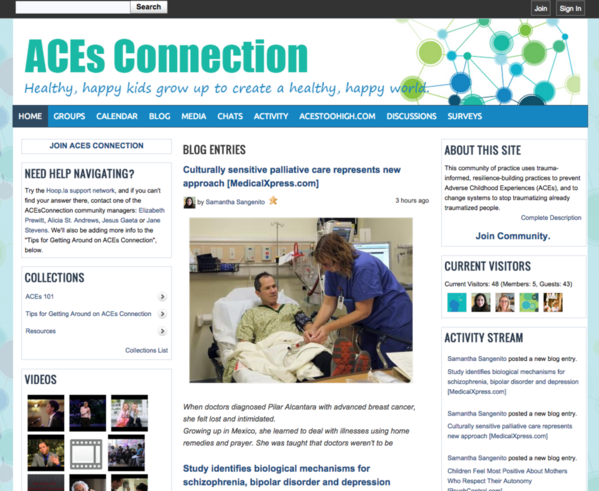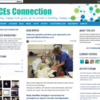She's running a community of practice with a very important mission.
Jane Stevens is the Founder/Editor of ACEsConnection.com, a thriving community of practice aimed at preventing Adverse Childhood Experiences (ACEs), and changing systems to stop traumatizing already traumatized people.
She shares the story of how her community became the impressive resource it is today.

Tell us your “founding story;” what made you decide to start ACEs?
Research has shown that adverse childhood experiences are the No. 1 cause of most of our chronic diseases, as well as mental illness, being violent and a victim of violence. That comes from 20 years of research that’s prompted a new understanding of human development and how toxic stress from adversity experienced early in childhood actually affects our behavior and becomes incorporated into our biology. So, as a science journalist, when I began to report about this, I knew that if communities were to achieve their health goals (reducing obesity, smoking, drinking to excess, drug abuse, domestic violence, heart disease, cancer, etc.), they would need to learn about this and address it.
There was no central place to learn about the research or how people were implementing it, or a place to share information about it. So, in January 2012 I launched ACEsTooHigh.com, a news site for the general public, and ACEsConnection.com, a social network for people who were implementing — or thinking about implementing — trauma-informed and resilience-building practices based on ACES research.
What do you think was the spark that made your original community get traction and thrive?
ACEsConnection grew slowly, as befits a community-of-practice social network. By May 2013, we passed 1,000 members at the same time that the Robert Wood Johnson Foundation sponsored the first National ACEs Summit. That was an important turning point. More people learned about it, and as more people became involved, it became more useful. In addition, RWJF learned about ACEsConnection. Early last year, they provided significant funding to grow the ACEs Connection Network, to give it the support we needed to continue to grow. By May of this year, we should be 4,000 members strong.
We continue to focus on slow growth, so that we can continue to respond to the needs of members and provide the resources they need to make changes in their communities.
You migrated from the Ning platform to Hoop.la; how did you handle that transition with your members? Any tips for others who might be considering a platform move?
We began alerting them to the move a month prior, provided updates in all of our communications with them (we do a daily digest, a weekly roundup, plus additional posts on the network), and sent out an email to all members twice before the day of the transition.
Once we made the transition, we sent out an email alerting them to the new platform, with instructions on how to sign in again. We posted a few how-tos, to which we’ve been adding since.
A week after the transition, we made sure that people knew we were available to assist.
Advice: Don’t change how the site looks right away. That’s what people seemed to be most worried about. If you’re planning on making design changes, make sure people get used to the platform first, then make changes gradually, if you can.
The transition went SO smoothly. Great wonderful kudos to the Hoop.la team, who answered all of our questions promptly, guided us through, and were very patient with our (continuing) learning curve. Our community is SO much happier on the Hoop.la platform. The more I use it, the more grateful I am that we made the move.
What’s your daily routine like? Are you proactive in keeping the conversation going on the site?
Our network comprises a daily digest of news, reports and research about adverse childhood experiences and trauma-informed/resilience-building practices; a weekly roundup; a resource center, and groups. The groups are the part of the site we’re focusing on growing this year. There are interest-based groups (ACEs in Education, ACEs in Pediatrics), and geographic-based groups (cities, counties and states).
The network is less about conversation than people working together on projects. We support a lot of work that occurs offline in communities. Last year we established our processes for starting and launching groups; this year we’re focusing on how to grow groups, with that combination of offline and online work. This week, for example, another community manager and I met with a large group of people in San Diego to officially launch the San Diego County ACEs Connection group. Two community managers joined the monthly meeting of the Sonoma County ACEs Connection group.
Our online activities include cross-posting blogs from the main site into groups whose members would be particularly interested in the information; providing links and contacts for members; posting comments to members’ posts; adding information to the main and groups’ resource sections; recruiting new members; helping communities build their groups; planning for in-person monthly meetings, etc. Members use the discussion section to post questions to members, which we include in the daily digest. Any discussions that occur usually appear in comments about a blog post. We plan on doing surveys and chats in groups this year.
What’s been your proudest moment as a community founder?
Many proud moments, when people tell me that they found a person, or received support or found information that they needed to move ahead in their communities with educating people about this research so that they can take the first steps toward implementing trauma-informed and resilience-building practices in all sectors of their community, including health, education, juvenile justice, business, faith-based and civic.
What’s your biggest challenge?
At this point, learning how best to grow the groups. And, of course, finding more hours in the day.
How are you measuring the success of the community, are you using any metrics? (If you’d like to share any numbers, we’d love it!)
Our site is less about the number of discussions or comments than it is what people do with the information, and if it speeds up their efforts. Those are more difficult metrics to figure out, and we’re working on how to do that.
Does your community have a big goal for 2015?
To grow the groups — we hope to see another 50 or 60 community groups start this year.
(Jane, thank you so much for taking the time to share your story with us! ~Rosemary)


Comments (2)